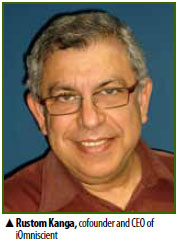IS It Worth It?
 Pricing for product placement varies widely. Vendors may provide props to be used in TV shows or movies, or provide services, such as consulting and installation services, in exchange for exposure. For example, in a high-tech thriller where dozens and dozens of cameras are needed, there may not be a need for monetary payment, Kimbrough said. “However, if vendors want their logos to be clearly seen by viewers, the cost varies from as little as US$5,000 to millions of dollars.”
Pricing for product placement varies widely. Vendors may provide props to be used in TV shows or movies, or provide services, such as consulting and installation services, in exchange for exposure. For example, in a high-tech thriller where dozens and dozens of cameras are needed, there may not be a need for monetary payment, Kimbrough said. “However, if vendors want their logos to be clearly seen by viewers, the cost varies from as little as US$5,000 to millions of dollars.”
The ROI for product placement is difficult to measure. Rather than showcasing a product to boost sales, the goal is to associate a brand with an emotion. Companies measure ROI differently, depending on what is most important to the company, Smallwood said. “Is it to get their product in front of a million people, or is it to align themselves with a blockbuster hit?”
ROI for product placement is more difficult to measure than it is for print advertisements because you have less control over the results, Meyer said. ”In product placement, you often don't have the final say in how your brand is featured. If it is an advertisement, not only do you have absolute control over the message, but it is in a different medium (print). You also have the opportunity in your own advertisement to place a call-to action that would increase your ROI.”
The generally accepted ROI model for product placement in films and TV is an “estimated media value” equation that takes into account what it would have cost to feature a product in commercial time, as well as the duration of the appearance and the quality of that appearance. It is similar in nature to “earned media,” which might be calculated following a PR function. It does not necessarily correlate to print media, Smallwood said.
It is important to note that in the case of surveillance cameras, the brand or product may not always be obvious to the viewer, so it is always better for the vendor to have other ways to capitalize on the exposure, Kimbrough said. For example, a Pelco camera appeared in Lady Gaga's music video "Telephone" for less than half a second, and the logo is impossible to spot, unless you specifically search for it and pause the video at the right time. “The way I work with my clients is that I let them know what I have done, so they can publicize it through other means,” Kimbrough added.
According to Kimbrough, Hitachi spent more than $40 million for the “War of the Worlds” marketing campaign. The campaign was “multitiered,” spanning television, print and online, and also included several innovative consumer activation tactics, according to Hitachi.
While ROI may sometimes be immediate, the effects of product placement in most cases are much more subtle, and could take a while before vendors realize its effectiveness. When Budweiser entered the Asian markets, it was surprised to discover that it was already a well-known brand. The reason for that was mainly because of product placements in films, which created strong brand awareness long before they even entered the market, Kimbrough said.
Managing Customer Expectations
Security vendors should tread carefully, however, lest the “CSI effect” kicks in and raises customer expectations to a level that is simply not achievable. Technology products need to have their capabilities shown in a positive light, but in some cases movie directors have shown features and benefits for technology products that are not part of the product's DNA, Smallwood said. "This could create an issue with current or future buyers of a product. With special effects, directors can take many liberties with a product and create a false sense of realism, which will make the phones of tech support and customer services of a product ring off the hook.”
If a technology product is featured in a film or TV show, will viewers have an expectation that the product will work for them exactly like it does in the show? In the early days of video analytics, few people understood the capabilities of the technology. When Hollywood movies presented them in impractical settings, people flocked to the new technology in wonder, expecting it to perform as it was portrayed on screen.” One similar example is the hit TV show “CSI: Crime Scene Investigation.” In the show, forensic investigators often “enhance” an image in ways that defy the laws of physics, such as enlarging and sharpening an image to see the reflection in a person's pupil and identify people or objects in the scene, regardless of the source's image quality.
 An unfortunate real-life example, albeit excellent anecdote, recently took place for Rustom Kanga, cofounder and CEO of iOmniscient. “Recently, my car was broken into in the U.K. Fortunately, the U.K. is reputed to have the highest number of cameras per head in the world, and there just happened to be a CCTV camera in the vicinity,” Kanga said. “However, when we saw the quality of the video captured by that camera, we realized that there was no point in having the camera there. The image quality was extremely poor, and the lack of proper maintenance made matters even worse. There was even a spider's web on the lens!" The image quality was not able to be "enhanced," because information that was not recorded cannot be magically generated. "Unfortunately, that is what you get in real life, not the fairy tale technology of Hollywood," Kanga added.
An unfortunate real-life example, albeit excellent anecdote, recently took place for Rustom Kanga, cofounder and CEO of iOmniscient. “Recently, my car was broken into in the U.K. Fortunately, the U.K. is reputed to have the highest number of cameras per head in the world, and there just happened to be a CCTV camera in the vicinity,” Kanga said. “However, when we saw the quality of the video captured by that camera, we realized that there was no point in having the camera there. The image quality was extremely poor, and the lack of proper maintenance made matters even worse. There was even a spider's web on the lens!" The image quality was not able to be "enhanced," because information that was not recorded cannot be magically generated. "Unfortunately, that is what you get in real life, not the fairy tale technology of Hollywood," Kanga added.
When a product is featured in a present-day show, viewers expect the product to work in real life similarly to how it was portrayed in the show or movie, Smallwood said. “However, if the product is featured in a fictional setting, or even a futuristic setting, viewers understand that the product usage also may be fictional in nature.” Depending on the occasion, it might be advisable to manage customer expectations.
iOmniscient puts in a lot of effort into educating customers on what is or is not possible, and believes that more sophisticated users understand the difference between science fiction and reality, Kanga said.
Five or six years ago, we would have said to our customers that they should not watch movies and television dramas such as CSI, and expect that level of fictional video analytics in real-life systems, Kanga said. “Today, we encourage our engineers to watch such fiction, with the intent of turning some of these ideas into reality.”
Commercially available video analytics of today is only around 10 years old, Kanga continued. “Consider the airplane industry in 1915, when it was 10 years old. If we look at what will be possible in video analytics in another 10, or 50 or 100 years, we would not be able to imagine what would be possible.”